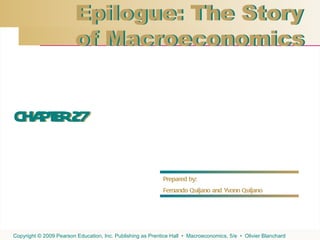Ch27 5e
•Transferir como PPT, PDF•
1 gostou•3,180 visualizações
- The document discusses the history and evolution of macroeconomic thought from Keynes' work in the 1930s establishing modern macroeconomics to recent developments. - It describes the neoclassical synthesis of the 1950s which integrated Keynesian and classical ideas and the influential IS-LM model. - In the 1970s, the rational expectations critique challenged Keynesian models and assumptions, leading to new classical, new Keynesian, and new growth theory work. - By the late 1980s, these schools of thought had integrated rational expectations and nominal rigidities into models still used today like New Keynesian and DSGE models.
Denunciar
Compartilhar
Denunciar
Compartilhar

Recomendados
Mais conteúdo relacionado
Mais procurados
Mais procurados (20)
Hypothesis of secular deterioration of terms of trade

Hypothesis of secular deterioration of terms of trade
types of inflation and inflationary and deflationary gap 

types of inflation and inflationary and deflationary gap
Schultz’s transformation of traditional agriculture

Schultz’s transformation of traditional agriculture
Semelhante a Ch27 5e
Semelhante a Ch27 5e (20)
Unit 1 (Introduction to Macro Economics) by Dr. Abhay Singh Chauhan

Unit 1 (Introduction to Macro Economics) by Dr. Abhay Singh Chauhan
Module 35 history and alternative views of macroeconomics

Module 35 history and alternative views of macroeconomics
What led to the demise of ‘conventional Keynesian wisdom’ in the mid.pdf

What led to the demise of ‘conventional Keynesian wisdom’ in the mid.pdf
MonetarismName of the studentName of the ProfessorNa.docx

MonetarismName of the studentName of the ProfessorNa.docx
Principle_of_effective_demand_-key_to_the_General_Theory (1).doc

Principle_of_effective_demand_-key_to_the_General_Theory (1).doc
Population Dynamics and Nonlinearities in Economic Systems 

Population Dynamics and Nonlinearities in Economic Systems
Último
APM Welcome
Tuesday 30 April 2024
APM North West Network Conference, Synergies Across Sectors
Presented by:
Professor Adam Boddison OBE, Chief Executive Officer, APM
Conference overview:
https://www.apm.org.uk/community/apm-north-west-branch-conference/
Content description:
APM welcome from CEO
The main conference objective was to promote the Project Management profession with interaction between project practitioners, APM Corporate members, current project management students, academia and all who have an interest in projects.APM Welcome, APM North West Network Conference, Synergies Across Sectors

APM Welcome, APM North West Network Conference, Synergies Across SectorsAssociation for Project Management
Último (20)
Measures of Central Tendency: Mean, Median and Mode

Measures of Central Tendency: Mean, Median and Mode
social pharmacy d-pharm 1st year by Pragati K. Mahajan

social pharmacy d-pharm 1st year by Pragati K. Mahajan
Disha NEET Physics Guide for classes 11 and 12.pdf

Disha NEET Physics Guide for classes 11 and 12.pdf
APM Welcome, APM North West Network Conference, Synergies Across Sectors

APM Welcome, APM North West Network Conference, Synergies Across Sectors
Interactive Powerpoint_How to Master effective communication

Interactive Powerpoint_How to Master effective communication
BAG TECHNIQUE Bag technique-a tool making use of public health bag through wh...

BAG TECHNIQUE Bag technique-a tool making use of public health bag through wh...
Ch27 5e
- 8. Lawrence Klein developed the first U.S. macroeconomic model in the early 1950s. The model was an extended IS relation, with 16 equations. 27-2 The Neoclassical Synthesis Progress on All Fronts Macroeconometric Models Klein
- 12. 27-2 The Neoclassical Synthesis The Phillips Curve Keynesians versus Monetarists The Phillips curve had become part of the Neoclassical synthesis, but Milton Friedman and Edmund Phelps argued that the apparent trade-off between unemployment and inflation would quickly vanish if policy makers actually tried to exploit it. By the mid 1970s, the consensus was that there was no long-run trade off between inflation and unemployment. Phelps
- 22. 27-3 The Rational Expectations Critique The Integration of Rational Expectations Wage and Price Setting Stanley Fischer and John Taylor showed that the adjustment of prices and wages in response to changes in unemployment can be slow even under rational expectations. They pointed to the staggering of both wage and price decisions, and explained how a slow return of output to the natural level can be consistent with rational expectations in the labor market. Fischer Taylor
- 24. 27-4 Recent Developments Since the late 1980s, three groups have dominated the research headlines: the new classicals, the new Keynesians, and the new growth theorists.
- 29. 27-4 Recent Developments New Growth Theory One example of some of the advances economists have made is on the work of Philippe Aghion and Peter Howitt. They have developed a theme first explored by Joseph Schumpeter in the 1930s, the notion that growth is a process of creative destruction , in which new products are constantly introduced, making old ones obsolete. Aghion Howitt
- 30. 27-4 Recent Developments New Growth Theory Andrei Shleifer (from Harvard University) has explored the role of different legal systems in affecting the organization of the economy, from financial markets to labor markets, and, through these channels, the effects of legal systems on growth. Daron Acemoglu (from MIT) has explored how to go from correlations between institutions and growth— democratic countries are on average richer—to causality from institutions to growth Shleifer Acemoglu
- 31. 27-4 Recent Developments New Growth Theory Woodford, Gali, and a number of co-authors have developed a model, known as the New-Keynesian model, that embodies utility and profit maximization, rational expectations, and nominal rigidities. This model has proven extremely useful and influential in the redesign of monetary policy. It has also led to the development of a class of larger models that build on its simple structure, but allow for a longer menu of imperfections and thus must be solved numerically. These models, which are now used in most central banks, are known as dynamic stochastic general equilibrium (DSGE) models. Woodford Gali